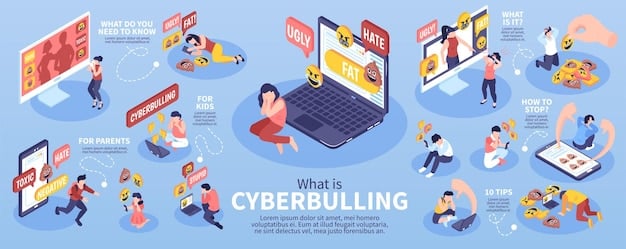Gen Z’s Fight Against Online Bullying: Can New Social Media Regulations Reduce Cyberbullying Incidents?

New social media regulations offer a hopeful pathway to mitigate cyberbullying, potentially reducing incidents by 15% in the next year, empowering Gen Z’s ongoing advocacy for safer digital spaces, but success hinges on rigorous implementation and platform accountability.
The fight against online bullying is a pivotal concern for today’s youth, especially as digital platforms increasingly shape their social lives. Can new social media regulations effectively reduce cyberbullying incidents by 15% in the next year? This question encapsulates the urgent need for tangible solutions in a landscape often fraught with digital aggressions and their far-reaching consequences.
Understanding the Cyberbullying Crisis from Gen Z’s Perspective
Cyberbullying represents a profound challenge for Gen Z, a generation that has grown up intrinsically linked to the digital world. Their lives unfold across platforms that, while offering connection and community, also present unprecedented avenues for harassment and abuse. This constant digital exposure means that negative online experiences can permeate every aspect of their reality, often with severe mental health consequences.
The nature of cyberbullying, distinct from traditional bullying, is amplified by its potential for anonymity, its relentless 24/7 presence, and the rapid dissemination of hurtful content. For Gen Z, who spend a significant portion of their daily lives online, distinguishing between their “real” and “digital” selves can be difficult, making them particularly vulnerable to the psychological impacts of sustained online aggression.
The Digital Landscape and its Impact on Youth Mental Health
The ubiquity of social media among Gen Z has undeniably reshaped their social interactions and emotional development. While these platforms can foster connections and self-expression, they also serve as breeding grounds for cyberbullying, body shaming, and exclusion. This persistent exposure to judgment and negativity can significantly erode self-esteem and contribute to severe mental health issues.
- Increased Anxiety and Depression: Constant exposure to online negativity, comparison, and fear of missing out (FOMO) can heighten feelings of anxiety and depression.
- Social Isolation: Despite being digitally connected, victims of cyberbullying often experience profound feelings of loneliness and isolation in real life.
- Suicidal Ideation: In severe cases, sustained cyberbullying has been tragically linked to increased risks of self-harm and suicidal thoughts among young people.
- Academic Decline: The psychological distress caused by cyberbullying can impact concentration, motivation, and overall academic performance.
Recognizing the profound impact of this digital environment on Gen Z’s well-being is the first crucial step toward developing effective interventions. Their active engagement with the digital world means that solutions must be embedded within the very platforms where these issues arise, making regulatory oversight indispensable.
Why Gen Z is Leading the Charge Against Online Harassment
Gen Z’s lived experience makes them uniquely positioned to lead the charge against online harassment. Having navigating this digital landscape since childhood, they possess an intrinsic understanding of its nuances, pitfalls, and potential for both good and harm. They are digital natives who grasp the insidious nature of cyberbullying far better than previous generations, recognizing its pervasive reach and the subtle forms it can take.
Their advocacy stems from a deep personal connection to the issue, having either experienced it firsthand, witnessed it affect their peers, or understood its detrimental effects on mental health. This lived experience fuels their resolve, transforming them from passive consumers of digital content into active proponents of change. They are not merely waiting for solutions; they are demanding them.
Furthermore, Gen Z is characterized by a strong sense of social justice and a willingness to speak out against perceived wrongs. They are adept at using the very platforms that enable cyberbullying to organize, raise awareness, and advocate for systemic changes. Their collective voice, amplified through online movements and direct engagement with policymakers and tech companies, is proving to be a powerful force in pushing for accountability.
The younger demographic’s activism is also a pragmatic response to the shortcomings of existing systems. They often feel misunderstood or unprotected by older generations and institutions regarding online safety. This perception catalyzes their independent efforts to forge safer digital environments, recognizing that their future, inextricably linked to the online sphere, depends on it. They leverage their digital literacy to inform, mobilize, and innovate, creating powerful narratives that resonate across generations and push for meaningful shifts in how online interactions are governed and perceived.
Key Provisions of New Social Media Regulations
Recent legislative efforts aim to tackle the pervasive issue of cyberbullying by placing greater responsibility on social media platforms. These regulations often focus on increasing transparency, improving reporting mechanisms, and enforcing stricter content moderation policies. The goal is to shift the onus of online safety from individual users to the platforms themselves, compelling them to create inherently safer digital environments.
Mandatory Reporting and Content Removal
One of the cornerstone provisions in many new regulations is the mandate for social media platforms to implement more efficient and accessible reporting mechanisms for cyberbullying. This goes beyond a simple “report” button; it demands clear, intuitive processes that allow users, particularly young people, to flag abusive content quickly and effectively. Critically, these provisions often include specific timelines within which platforms must review and act upon these reports.
Beyond reporting, the regulations frequently stipulate mandatory content removal for verified instances of cyberbullying. This means that once harassment is identified, platforms are legally obligated to take it down expeditiously. The aim is to significantly reduce the exposure of victims to harmful content and prevent its further dissemination. This proactive approach by platforms, spurred by regulatory requirements, could mark a significant shift from the previous, often reactive, stance on content moderation.
The challenge lies in ensuring that these removal processes are both swift and accurate, avoiding unnecessary censorship while prioritizing user safety. This balance requires significant investment in AI tools, human moderation teams, and robust appeal processes for content creators. Effective implementation of mandatory reporting and removal can create a powerful deterrent against online aggressions, making platforms less hospitable for those engaging in bullying behavior.
Age Verification and Parental Controls
New social media regulations are increasingly exploring the implementation of more stringent age verification processes and enhanced parental controls. The rationale behind this is to protect younger users, who are often more vulnerable to cyberbullying and exploitation online. Accurate age verification aims to prevent underage individuals from accessing content or platforms that are not appropriate for their developmental stage, thereby reducing their exposure to potential harm.
Parental controls, on the other hand, empower guardians to monitor and manage their children’s online activity. These controls might include features such as screen time limits, content filtering, and the ability to review who their children are interacting with. While these measures introduce debates around privacy and parental oversight, they are designed to provide an additional layer of protection, particularly for very young users.
The technical complexities of implementing robust age verification without infringing on privacy rights are considerable. Similarly, parental controls require user adoption and education to be truly effective. However, the intent is clear: to build safer digital ecosystems by recognizing the unique vulnerabilities of younger users and providing tools for both platforms and parents to mitigate risks effectively. This dual approach signifies a collaborative effort to shield the most susceptible members of Gen Z from the harsh realities of online aggression.
Increased Platform Accountability and Fines
A crucial element of the evolving regulatory landscape is the emphasis on increased platform accountability. Rather than merely recommending best practices, these new regulations often assign legal responsibilities to social media companies for the content hosted on their sites and the safety of their users. This shift signifies a departure from the previous “hands-off” approach, where platforms were often viewed more as neutral conduits for information.
To ensure compliance and incentivize swift action, these regulations frequently include provisions for substantial fines and penalties for platforms that fail to adhere to the stipulated safety measures. These financial deterrents are designed to make it more costly for platforms to ignore their responsibilities than to invest in robust content moderation, reporting mechanisms, and user protection features. The size of these fines can be significant, reflecting the severe impact of online harms on individuals and society.
- Financial Penalties: Imposing hefty fines for non-compliance, proportional to the platform’s revenue, to serve as a strong deterrent.
- Legal Actions: Allowing government bodies or even individuals to pursue legal action against platforms for negligence in addressing cyberbullying.
- Reputational Damage: Publicizing non-compliance to incentivize platforms, as reputational harm can be as damaging as financial penalties.
- Mandatory Audits: Requiring independent audits of content moderation and safety protocols to ensure transparency and effectiveness.
This increased accountability framework aims to compel social media companies to prioritize user safety as seriously as they prioritize user engagement and revenue. The threat of financial and reputational repercussions is a powerful lever to drive necessary systemic changes. By making platforms directly responsible, policymakers hope to foster an environment where mitigating cyberbullying is not just a moral imperative but a legal and business necessity.
Challenges and Criticisms of New Regulations
While the intent behind new social media regulations is laudable, the path to effective implementation is fraught with challenges. Critics often point to practical difficulties in enforcement, the risk of overreach, and the fundamental tension between content moderation and freedom of speech. Navigating these complexities is crucial for any regulation to be truly effective and broadly accepted.
Defining and Moderating “Bullying” Content
One of the most significant hurdles in regulating online behavior is the inherently subjective nature of defining “bullying” content. What constitutes bullying for one individual might be considered robust debate or even humor by another. While overt threats and hate speech are relatively straightforward to identify, much of cyberbullying exists in a gray area, encompassing subtle forms of harassment, exclusion, and psychological manipulation.
Platforms are tasked with distinguishing between offensive content and genuine bullying, which requires context, cultural understanding, and a nuanced interpretation of interactions. Automating this process, even with advanced AI, proves incredibly difficult. Human moderators are indispensable but face immense pressure, often leading to burnout and inconsistencies. The sheer volume of content uploaded daily adds another layer of complexity, making comprehensive and accurate moderation an almost Sisyphean task.
Moreover, aggressive moderation policies, in an attempt to curb bullying, risk infringing on free speech. Users often fear that their legitimate criticisms or expressions could be misconstrued as bullying and lead to unwarranted content removal or account suspension. Striking the right balance between protecting vulnerable users and upholding freedom of expression is an ongoing ethical and practical dilemma for regulators and platforms alike.
This ambiguity in definition can also lead to inconsistent enforcement across different platforms or even within the same platform globally, further complicating the user experience. For regulations to be truly effective, there needs to be a clearer, more universally accepted framework for identifying and addressing the diverse forms of cyberbullying without stifling legitimate discourse.
Technological Limitations and Global Compliance
Implementing new social media regulations faces substantial technological limitations, especially given the global nature of these platforms. Developing advanced AI and machine learning tools capable of accurately identifying nuanced forms of cyberbullying across countless languages and cultures is an enormous undertaking. Even with sophisticated technology, the sheer volume of daily content makes real-time, comprehensive moderation incredibly difficult. Many smaller platforms also lack the resources of tech giants to invest in such sophisticated systems, potentially making compliance inequitable.
Furthermore, ensuring global compliance presents a significant challenge. Internet borders are fluid, and a regulation enacted in one country may struggle to impact platforms operating internationally or users accessing content from different jurisdictions. This creates a patchwork of legal requirements, making it difficult for platforms to establish a single, unified approach to content moderation and user safety. The principle of national sovereignty often clashes with the global reach of digital platforms, leading to potential legal conflicts and enforcement loopholes. Harmonizing international approaches remains an elusive goal, yet it is critical for truly mitigating a global problem like cyberbullying.
Impact on Free Speech and Innovation
A primary concern surrounding increased social media regulation is its potential chilling effect on free speech. Critics argue that overly broad or stringent rules, especially those requiring rapid content removal, could lead platforms to err on the side of caution and censor legitimate expression to avoid penalties. This could stifle open debate, political discourse, and artistic expression, turning platforms into overly sanitized spaces devoid of critical viewpoints.
- Censorship Concerns: Platforms may remove content preemptively, fearing fines, leading to self-censorship among users.
- Reduced Open Debate: Fear of misinterpretation or algorithmic flagging could discourage users from participating in robust discussions on sensitive topics.
- Impact on Marginalized Voices: Free speech protections are crucial for minorities and activists who rely on platforms to challenge existing norms and advocate for their rights. Over-regulation might disproportionately affect these groups.
- Innovation Stifled: Strict regulatory burdens could discourage new social media companies from entering the market or existing ones from innovating, due to the high costs of compliance and the fear of legal repercussions.
Moreover, the compliance burden – including building robust moderation systems, age verification tools, and intricate reporting mechanisms – disproportionately affects smaller startups. This could entrench the dominance of large tech companies, which have the resources to meet regulatory demands, thereby stifling innovation and reducing competition in the digital space. The balance between fostering a safe online environment and preserving fundamental freedoms and a dynamic tech ecosystem is delicate and subject to ongoing debate.
Expected Outcomes and Metrics for Success
The ambitious goal of reducing cyberbullying incidents by 15% within the next year hinges on defining clear, measurable outcomes and robust metrics for success. Moving beyond anecdotal evidence, a data-driven approach is essential to assess the efficacy of new regulations and justify ongoing policy interventions. Success will not merely be the absence of incidents, but a measurable shift in user experience and platform behavior.
Reduced Incidence Rates of Cyberbullying
The most direct measure of success for new social media regulations will be a tangible reduction in the reported and verified incidence rates of cyberbullying. This requires platforms to transparently collect and share data on flagged content, user reports, and the outcomes of their moderation processes. A 15% reduction is an ambitious target, requiring a concerted effort from all stakeholders.
Measuring this reduction will involve comparing baseline data from before the regulations were enacted with data collected consistently in the subsequent year. This includes tracking:
- Number of reported incidents: A decrease in formal reports to platforms and authorities.
- Volume of harmful content: A reduction in the actual amount of bullying content identified and removed.
- User surveys: An increase in self-reported feelings of safety and a decrease in experiences of cyberbullying from surveys conducted among Gen Z.
- Mental health indicators: Long-term tracking of trends in anxiety, depression, and other mental health challenges linked to cyberbullying among the youth cohort.
Achieving a 15% reduction will signal that the combination of stricter accountability for platforms, improved reporting tools, and enhanced content moderation is creating a less permissive environment for bullies. It will also indicate that victims feel more empowered to report and that their concerns are being addressed effectively by the platforms responsible.
Improved Reporting and Response Times
Beyond the raw reduction in incidents, a key indicator of regulatory success will be a marked improvement in how platforms handle reported cyberbullying. This means not just that reports are made, but that they are acted upon swiftly and transparently. Faster response times are crucial, as extended exposure to bullying content can exacerbate psychological distress for victims.
Metrics for this area of success include:
- Average time to review a report: A significant decrease in the time it takes for platforms to review and categorize a reported incident.
- Average time to content removal: A reduction in the period from validation of bullying content to its actual removal from the platform.
- User satisfaction with reporting process: Surveys indicating a higher satisfaction rate among users who have reported cyberbullying, regarding the ease of process, clarity of communication, and perceived fairness of outcome.
- Transparency in moderation actions: Platforms providing clearer feedback to users about what actions were taken in response to their reports, even if content is not removed.
Improved reporting and response times signify that platforms are taking their compliance obligations seriously and are investing in the necessary infrastructure and personnel. This responsiveness not only mitigates immediate harm but also builds trust among users, encouraging them to utilize the official reporting channels rather than resorting to less effective coping mechanisms. Such improvements validate the regulatory push for greater platform accountability.
Enhanced User Trust and Engagement
Ultimately, the success of new social media regulations will be reflected in an enhanced sense of trust among Gen Z users and a sustained, healthier engagement with online platforms. If young people feel safer and more protected, they are more likely to participate positively, express themselves authentically, and build genuine communities online. Reduced fear of harassment can unlock the full potential of digital spaces as platforms for connection and learning.
Metrics for gauging enhanced user trust and engagement could include:
- Increased positive sentiment: Monitoring social media discussions for a shift towards more positive conversations about platform safety and user experience, particularly from Gen Z.
- Engagement with safety features: Users actively utilizing and promoting platform safety tools, such as blocking, muting, and privacy settings.
- User retention and growth among Gen Z: While overall numbers fluctuate, a positive trend in this demographic’s continued use or even increased adoption of platforms perceived as safer.
- Reduced “digital detox” trends: Fewer Gen Z individuals feeling compelled to take extended breaks from social media due to negative experiences related to bullying.
- Perceived sense of community: Survey data indicating that Gen Z users feel more connected and less isolated on regulated platforms.
Earning and maintaining user trust is a critical long-term outcome. When users feel safe and valued, they are more likely to invest their time and creativity into the platform, fostering a more vibrant and constructive digital ecosystem. This not only benefits the users themselves but also strengthens the platforms by cultivating a loyal and engaged user base committed to a positive online experience, free from the shadow of cyberbullying.
The Role of Education and Digital Literacy
While new regulations play a critical role in shaping platform behavior, legislative efforts alone cannot fully eradicate cyberbullying. Complementary to regulatory frameworks, comprehensive education and enhanced digital literacy are indispensable tools in empowering Gen Z to navigate the complexities of the online world. Equipped with knowledge and critical thinking skills, young people can become proactive agents of change.
Empowering Gen Z with Digital Citizenship Skills
Digital citizenship goes beyond simply knowing how to use technology; it encompasses a set of skills, knowledge, and ethical principles that enable individuals to participate safely, responsibly, and effectively in the digital world. For Gen Z, who are digital natives, cultivating these skills is paramount in the fight against cyberbullying. It empowers them to recognize, respond to, and prevent online harms, both as potential victims and as active bystanders.
Key components of digital citizenship education include:
- Critical thinking about online content: Teaching users to discern credible information from misinformation, and to critically evaluate the intentions behind online interactions.
- Responsible online behavior: Educating about the consequences of their digital footprints, promoting empathy, and fostering respectful communication.
- Privacy and security awareness: Understanding how to protect personal information, recognize phishing attempts, and manage privacy settings effectively.
- Recognizing and reporting cyberbullying: Equipping individuals with the ability to identify different forms of online harassment and knowledge of the appropriate channels for reporting.
- Media literacy: Understanding how social media algorithms work, the influence of online trends, and how content is created and disseminated.
By integrating digital citizenship into school curricula and community programs, young people can learn to navigate negative online experiences with resilience, advocate for themselves and others, and contribute positively to digital communities. This proactive approach fosters self-awareness and ethical conduct, making Gen Z less susceptible to becoming either victims or perpetrators of cyberbullying, thereby fortifying the impact of regulatory interventions.
Parental and Educator Involvement
The involvement of parents and educators is crucial in complementing the effects of social media regulations and bolstering digital literacy among Gen Z. These trusted adults serve as critical guides, helping young people navigate the often-complex digital landscape, understanding the risks, and fostering healthy online habits. Their active participation creates a supportive ecosystem where regulations can truly thrive.
For parents, this involves understanding the platforms their children use, engaging in open conversations about online experiences, and modeling responsible digital behavior. It means moving beyond simply restricting access to teaching critical thinking and resilience. Parental control tools, while useful, are most effective when coupled with ongoing dialogue and trust. They need to understand what constitutes cyberbullying, how to report it, and how to support their children if they become targets or witnesses.
Educators, on the other hand, are ideally positioned to integrate digital literacy and citizenship into formal learning environments. This includes developing curricula that address online safety, ethical technology use, and critical media consumption. Teachers can facilitate discussions, provide practical advice, and create safe spaces where students can articulate their online challenges without fear of judgment. Their role is to not just educate but to empower students with the tools and confidence to be responsible digital citizens.
Collaboration between parents, educators, and even platforms is essential. Workshops, webinars, and accessible resources can bridge knowledge gaps, ensuring that all adults involved in a child’s life are equipped to support their online well-being. This multi-stakeholder approach creates a more comprehensive defense against cyberbullying, going beyond mere compliance to foster a genuinely safer online culture.
Community-Led Initiatives and Peer Support
Alongside regulatory and educational efforts, community-led initiatives and peer support networks play a vital role in the fight against cyberbullying. Gen Z, being highly interconnected, often finds solace and strength within their own peer groups. These grassroots efforts can complement top-down approaches by fostering a culture of empathy, mutual support, and collective responsibility within online and offline communities.
Community initiatives can take various forms:
- Youth-led advocacy groups: Organizations and movements spearheaded by young people themselves to raise awareness, share personal stories, and lobby for change.
- Online support forums and hotlines: Safe, moderated spaces where victims can share experiences, receive advice, and find emotional support from peers and trained counselors.
- Anti-bullying campaigns: Local and national campaigns, often featuring Gen Z voices, to promote kindness, discourage aggressive online behavior, and highlight the consequences of cyberbullying.
- Workshops and training: Peer-to-peer education sessions on digital etiquette, recognizing signs of bullying, and intervention strategies for bystanders.
Peer support is particularly powerful because it comes from individuals who understand the unique dynamics of Gen Z’s digital lives. Young people are often more willing to open up to their peers than to adults, leading to more effective interventions and a stronger sense of solidarity. These initiatives empower Gen Z not just as recipients of protection but as active participants in creating safer, more compassionate digital spaces for themselves and future generations. Such collective action reinforces the message that cyberbullying is unacceptable and that help is always available within their community.
The Future of Online Safety: Beyond 2025
Looking beyond the immediate goal of a 15% reduction in cyberbullying incidents by next year, the future of online safety for Gen Z will require continuous adaptation and innovation. The digital landscape is ever-evolving, and vigilance will be paramount to stay ahead of emerging threats and ensure that the online world remains a space for growth, connection, and positive expression rather than a source of harm.
Continuous Adaptation and Innovation in Regulation
The pace of technological change often outstrips the speed of legislation. Therefore, effective regulation of social media and online behavior cannot be a static endeavor; it must be characterized by continuous adaptation and innovation. New platforms, new forms of interaction, and new methods of harassment emerge constantly, necessitating agile policy responses that anticipate rather than merely react to these developments.
This includes:
- Regular Review Mechanisms: Establishing frameworks for periodic review of existing regulations to assess their effectiveness and adjust them based on real-world outcomes and technological advancements.
- Proactive Policymaking: Fostering collaboration between lawmakers, technology experts, and youth advocates to foresight potential harms and legislate pre-emptively.
- Global Harmonization Efforts: Working towards international cooperation on regulatory standards to avoid fragmented approaches and create a more uniformly safe global internet.
- Incentivizing Ethical Design: Encouraging platforms to adopt “safety by design” principles, where user well-being and protection are considered from the initial stages of product development.
The goal is to create a regulatory ecosystem that is flexible enough to address emergent issues while remaining principled in its commitment to user safety. This proactive and iterative approach to regulation will be essential in ensuring that the digital environment remains accountable and responsive to the needs of Gen Z and future generations, rather than playing constant catch-up with harmful trends.
Integrating AI and Human Oversight
The future of online safety will heavily rely on a sophisticated integration of artificial intelligence and robust human oversight. While AI offers unparalleled speed and scale in detecting harmful content, it lacks the nuanced understanding and contextual judgment of human moderators. The synergy between these two components is crucial for effective and ethical content moderation, particularly in the complex realm of cyberbullying.
AI can be leveraged for:
- Automated Detection: Rapidly scanning vast amounts of content for patterns indicative of hate speech, threats, or harassment.
- Real-time Filtering: Blocking obviously harmful content before it reaches a wide audience.
- Flagging for Review: Prioritizing content that requires human review, thereby increasing the efficiency of human moderation teams.
- Trend Analysis: Identifying emerging forms of online abuse and adapting moderation strategies accordingly.
However, human oversight remains indispensable for:
- Contextual Understanding: Interpreting intent, cultural nuances, and the subjective nature of bullying that AI often misses.
- Decision Making: Making final judgments on complex or borderline cases, ensuring fairness and preventing algorithmic bias.
- Appeals Process: Providing human review for users who believe their content was wrongly removed.
- Training AI: Continuously feeding data and insights back to AI systems to improve their accuracy and reduce errors.
This dual approach ensures that moderation is both efficient and equitable, constantly learning and adapting. The goal is not to replace human judgment with algorithms but to empower human judgment with advanced technological support. This balance is critical for fostering user trust and effectively combating the evolving challenges of cyberbullying on a global scale.
Fostering a Culture of Digital Empathy
Beyond regulations and technological solutions, the ultimate objective for online safety is to foster a pervasive culture of digital empathy. This means shifting the paradigm from merely enforcing rules to cultivating inherent kindness, understanding, and respect within online interactions. For Gen Z, who spend so much of their lives digitally connected, nurturing this empathy is foundational to creating genuinely safe and positive online spaces.
Fostering digital empathy involves:
- Promoting Positive Online Conduct: Encouraging users to think about the impact of their words and actions on others, emphasizing human connection over anonymity.
- Teaching Perspective-Taking: Helping users understand that behind every screen name is a real person with feelings and experiences.
- Highlighting Consequences: Educating about the real-world psychological and emotional harm that cyberbullying inflicts.
- Encouraging Bystander Intervention: Empowering individuals to speak up or report when they witness online harassment, transitioning from passive observers to active allies.
- Celebrating Inclusivity: Actively promoting diverse voices and communities online, ensuring platforms are welcoming to all identities and viewpoints.
A culture of digital empathy relies on education, consistent messaging from platforms and influential figures, and peer-to-peer reinforcement. It recognizes that while regulations can deter negative behavior, true safety comes from a community that collectively values respectful interaction. By instilling these values, the online world can evolve into a space where Gen Z thrives, unburdened by the fear of bullying, and is free to explore, learn, and express themselves creatively and safely.
| Key Aspect | Brief Description |
|---|---|
| 🛡️ Gen Z Advocacy | Youth are leading the charge for safer online spaces due to lived experiences. |
| ⚖️ New Regulations | Laws aim for mandatory reporting, age verification, and platform accountability. |
| 🎯 15% Reduction Goal | Target for cyberbullying incidents hinges on effective regulatory implementation. |
| 📚 Digital Literacy | Education, parental, and community involvement are crucial alongside laws. |

Frequently Asked Questions About Cyberbullying and Regulations
Cyberbullying involves using digital technologies to repeatedly harass, threaten, embarrass, or target another person. This can include spreading rumors, posting lies, sharing private photos, sending hurtful messages, or excluding someone from online groups. Unlike traditional bullying, cyberbullying can occur 24/7 and content can be permanent and widely disseminated, making it particularly insidious and difficult to escape.
Gen Z grew up with ubiquitous internet access and social media, making their lives deeply intertwined with digital platforms. This constant online presence makes them highly susceptible to cyberbullying, as it affects their social identity, mental health, and daily interactions. Their digital-native status means negative online experiences can have a profound and inescapable impact on their self-perception and well-being.
New regulations typically focus on holding platforms accountable through mandatory reporting mechanisms, stricter content removal policies, and robust age verification processes. They may also include provisions for substantial fines for non-compliance, forcing platforms to invest more in moderation and user safety. The goal is to make platforms less hospitable for bullies and safer for users.
Criticisms often center on the difficulty of defining and consistently moderating “bullying” content across diverse contexts, potential technological limitations, and the challenge of global compliance for international platforms. There are also significant concerns about the impact on free speech, with fears that overly strict regulations could lead to excessive censorship and stifle innovation within the tech industry.
Beyond regulations, comprehensive digital literacy education is vital, empowering Gen Z with critical thinking and responsible online behavior skills. Parental and educator involvement, fostering open dialogue and providing guidance, is also key. Additionally, community-led initiatives and peer support networks create a culture of digital empathy, encouraging positive interactions and collective responsibility against cyberbullying.

Conclusion
The aspiration to reduce cyberbullying incidents by 15% in the next year, particularly for Gen Z, is a challenging yet crucial objective that intertwines regulatory action with broader societal efforts. While new social media regulations offer a vital framework for platform accountability and improved safety features, their success hinges on effective implementation, continuous adaptation, and a deep understanding of the digital landscape’s complexities. Ultimately, true online safety goes beyond legislation, requiring a concerted focus on digital literacy, parental and educational involvement, and fundamentally, fostering a culture of digital empathy that empowers Gen Z to lead the charge in building a more respectful and secure online future.





